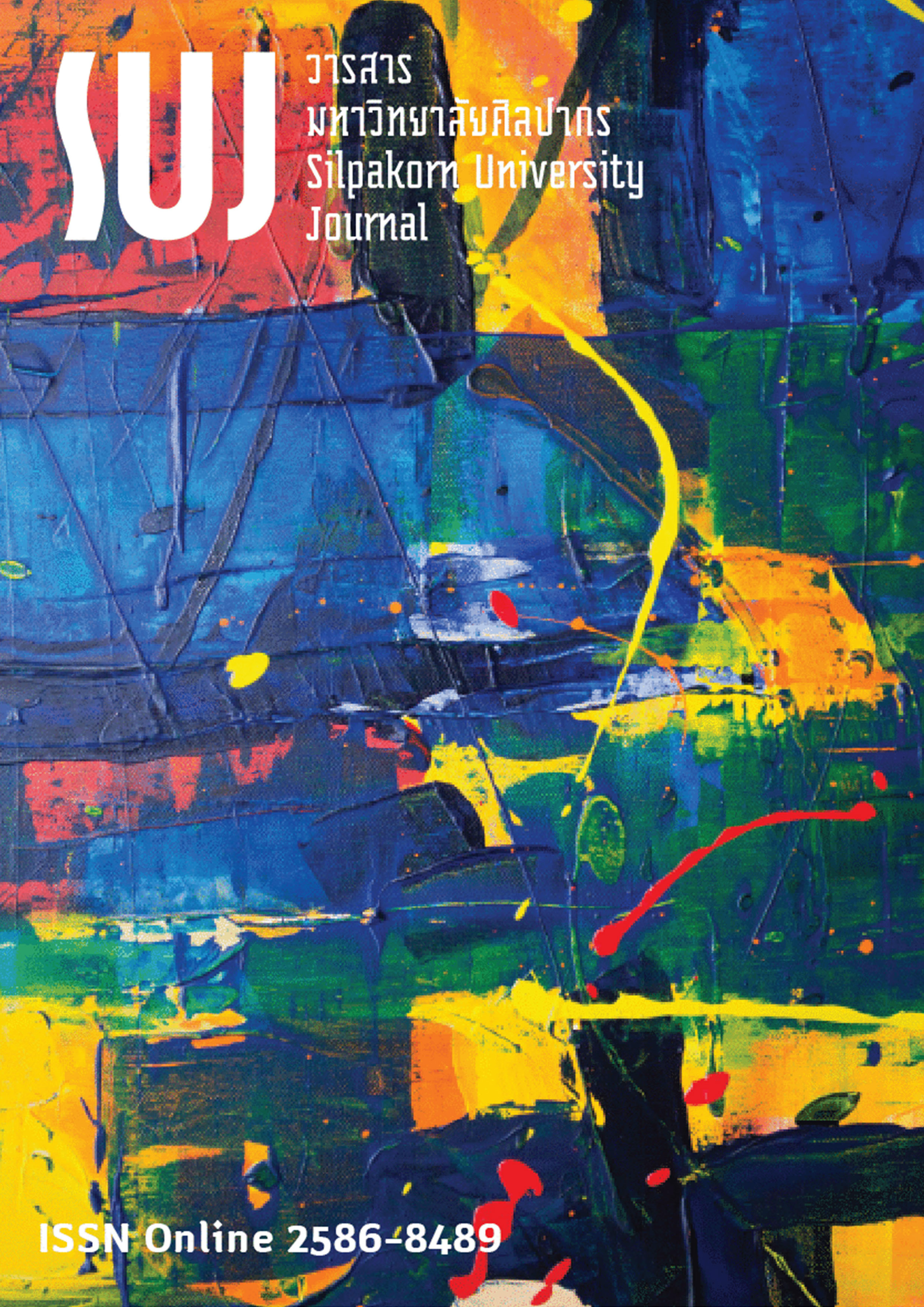การปลูกฝังการเรียนรู้ของเด็กด้วยสายสัมพันธ์รังสรรค์ศิลปะ (Encouraging children’s process of learning with creative art)
Main Article Content
Abstract
งานวิจัยสร้างสรรค์นี้มีวัตถุประสงค์เพื่อศึกษาและสร้างกระบวนการปลูกฝังที่สามารถสร้างการเรียนรู้ต่อเด็กด้วยหลักการทางศิลปะ และพัฒนาต่อยอด เพื่อสร้างสรรค์ผลงานตามกระบวนการปลูกฝังภายใต้กรอบแนวคิดสายสัมพันธ์รังสรรค์ศิลปะ พร้อมทั้งวิเคราะห์และประเมินแนวทางการปลูกฝังด้วยหลักการนำศิลปะร่วมกับข้อมูลความรู้ ซึ่งมีกระบวนการวิจัย 4 ขั้นตอน ดังนี้ 1. ขั้นตอนศึกษาพฤติกรรมความชอบของเด็ก ๆ และสร้างกิจกรรมการเรียนรู้ต่าง ๆ 2. การออกแบบผลงานสร้างสรรค์ สรุปแนวคิดเนื้อหาเชิงประวัติศาสตร์ วางโครงสร้างเทคนิคและสร้างสรรค์ผลงาน 3. การจัดแสดงผลงานเพื่อนำเสนอผลงานต่อกลุ่มผู้ทรงคุณวุฒิและผู้ชมทั่วไป 4. สรุปผลการวิจัย และจัดทำรายงานฉบับสมบูรณ์ ผลการวิจัยสร้างสรรค์แบ่งเป็น 2 ส่วน ดังนี้ ส่วนที่ 1 กระบวนการปลูกฝังสามารถสร้างการเรียนรู้ต่อเด็กด้วยหลักการทางศิลปะ ผู้วิจัยพบข้อสรุปของแนวคิด (mind mapping) และกระบวนการสร้างกิจกรรมสร้างสรรค์ 3 กระบวนการ คือ 1) ให้เด็กทำในสิ่งที่ชอบ 2) เรียนรู้นอกสถานที่ 3) แทรกเนื้อหาวิชาการ ส่วนที่ 2 สร้างสรรค์ผลงานตามกระบวนการปลูกฝังภายใต้กรอบแนวคิดสายสัมพันธ์รังสรรค์ศิลปะ ซึ่งผลงานที่ได้ประกอบด้วย ผลงานขนาด A2 รูปแบบสื่อผสมแสดงเนื้อหาโบราณสถานโบราณวัตถุ ผลงานภาพเขียนลายเส้นโบราณวัตถุ ผลงานปั้นดินน้ำมันรูปทรงโบราณสถานโบราณวัตถุ และสติกเกอร์ จากนั้นนำผลงานเข้าติดตั้งเพื่อจัดแสดง ซึ่งผลวิเคราะห์แนวทางการปลูกฝังด้วยหลักการนำศิลปะร่วมกับข้อมูลความรู้ถือได้ว่าประสบผลสำเร็จ และเป็นที่ยอมรับ เนื่องจากผู้ทรงคุณวุฒิชื่นชมผลงานและได้รับคัดเลือกให้ได้รับรางวัลดีเด่น นอกจากนี้ผู้วิจัยได้เฝ้าติดตามผู้ร่วมโครงการวิจัยซึ่งพบว่ามีพฤติกรรมต่อเนื่องในการชื่นชอบการทำงานศิลปะ เรียนรู้ประวัติศาสตร์ พัฒนาสิ่งที่ชอบจนสามารถเป็นแรงบันดาลใจให้ครอบครัวได้รวบรวมผลงานเพื่อจัดแสดงครั้งต่อไป
This creative research was aimed at 1. studying children’s processes of learning by incorporating artistic principles, 2. developing creative works under the conceptual framework of art creation, and 3. analyzing and evaluating the approach to encourage children’s learning process. For the research methodology, there are 4 stages of research as follows: 1. studying children’s preferences and creating learning activities, 2. designing creative art, conceptualizing historical content, developing structural techniques and creating artwork, 3. displaying an exhibition to present the artwork to peer groups and general audiences, and 4. concluding the findings and writing a complete report. The findings of the creative research could be divided into two parts. First, the artistic principles are successful in encouraging children’s process of learning. The mind mapping and the process of creating creative activities include 1) letting the kids do what they like, 2) having children enjoy outdoor activities, 3) strengthening children’s knowledge while they are doing some activities. Second, creative works were produced, using the selected conceptual framework of art-creation. The works are, for example, A2-sized mixed media works, showing the content of ancient artifacts, antique paintings, antique-shaped oil sculptures, and stickers. Regarding its result, this project was considered successful as the artwork from the project was well-received by peer groups. In addition, after having been monitored, the participants of the research project constantly showed their passion for art or create artwork, learned history, and developed artwork as outcomes of their passions.
Downloads
Article Details

This work is licensed under a Creative Commons Attribution-NonCommercial-NoDerivatives 4.0 International License.
References
Bunnakh, Khanitha. (2019). Creative Arts Activities for Early Childhood (การจัดกิจกรรมศิลปะสร้างสรรค์ สำหรับเด็กปฐมวัย). [Online]. Retrieved January 27, 2021 from https://www.youngciety.com/article/journal/arts-for-kids.html
Niamhom, Narumol. (2021). Providing Appropriate Learning Experiences for Early Childhood (การจัดประสบการณ์การเรียนรู้ที่เหมาะสมสำหรับเด็กปฐมวัย). [Online]. Retrieved January 27, 2021 from http://www.nareumon.com/index.php?option=com_content&task=view&id=19&Itemid=50&limit=1&limitstart=2
Nolte, D. L., & Harris, R. (2020). Children Learn What They Live (ชีวิตเด็กจะดีขึ้นอยู่กับวิธีของพ่อแม่เพราะเด็กเรียนรู้จากการใช้ชีวิต). Translated by Nalinee Chuawanitchakorn. Nonthaburi: Bee Media Group (Thailand) Co., Ltd.
Phlitphlkanphim, Prasert. (2020). 100 Lessons Raising a Baby Gen Alpha (100 บทเรียนเลี้ยงลูกเจนอัลฟ่า) (3rd ed.). Bangkok: Amarin Kids Amarin Printing and Publishing.
Srisuk, Phaphan. (2018). What’s the Smart Kid? Can Tell by Playing (ลูกฉลาดด้านใด บอกได้จากการเล่น). [Online]. Retrieved January 20, 2021 from https://www.trueplookpanya.com/knowledge/content/68703/-parpres-par-parsch-
Taweewattanawong, Benjaporn. (2018). IQ EQ Children’s Can Be Grown (IQ EQ ลูกปลูกได้). Bangkok: Love and Lip Tress Co., Ltd.
Thouthong, Preecha. (2021, May 17). Requesting for Positions and Academic Works without Textbooks or Research Papers (การขอตำแหน่งและผลงานวิชาการโดยไม่ต้องใช้ตำราหรืองานวิจัย) [Conference session]. KMUTNB 7th International Art and Design Workshop 2021, King Mongkut’s University of Technology North Bangkok, Thailand.


